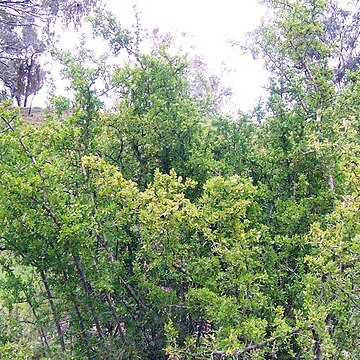Shrubs, often spiny, usually glabrous. Leaves alternate or clustered, simple, entire, shortly petiolate. Flowers solitary or in small groups at nodes, bisexual, actino– morphic. Calyx tubular to campanulate, unevenly 4–5–lobed, sometimes 2–lipped. Corolla funnel-shaped, creamy white to lilac, soon turning brown; limb 4–5–lobed, the lobes imbricate in bud. Stamens usually 5, unequal, inserted towards base of corolla-tube; anthers bilocular, not cohering, dorsifixed, dehiscing by longitudinal slits. Ovary bilocular; stigma capitate. Fruit a succulent berry, partially enclosed by calyx. Seeds asymmetrically D-shaped.
Shrubs, usually spiny. Lvs deciduous or evergreen, alternate or in fascicles on short spurs, simple, entire, usually glabrous, sessile or shortly petiolate. Fls solitary or few in clusters, axillary. Calyx scarcely accrescent; tube campanulate, regular or ± bilabiate; teeth 3-5, equal or unequal. Corolla funnelform, often cylindric in lower part, sometimes salverform, usually purple to whitish, (4)-5-(7)-lobed. Stamens inserted in throat of corolla, exserted, often with band of hairs near filament base. Stigma shallowly 2-lobed, sometimes capitate. Fr. a berry; seeds few to many, of moderate size.
Stamens (4)5, from unequal to subequal, the filaments inserted from just above the base of corolla tube to just below the corolla mouth, subulate (elsewhere sometimes basally enlarged and glandular), usually pilose at the base, included or exserted; anthers all fertile in bisexual or functionally male flowers, sterile in functionally female flowers, ovate-oblong to ovate in outline, dorsifixed with the thecae separated from each other for the lower third or half, dehiscing by longitudinal slits.
Cal 4–5-lobed, campanulate to tubular, ruptured by the growing fr; cor tubular to funnelform, 4–5-lobed; anthers longitudinally dehiscent, much shorter than the slender filaments; fr a fleshy or dry berry; seeds 2–many, somewhat compressed, with strongly curved embryo; shrubs or small trees, usually thorny, with entire or minutely toothed, often fascicled lvs, the fls mostly 1–4 in the axils. 100, widespread.
Corolla tubular or infundibuliform to campanulate, somewhat restricted above the ovary before expanding, variously coloured, pilose on the inside at the point of filament insertion and below it or sometimes glabrous; limb (4)5-lobed in the Flora Zambesiaca area, spreading or reflexed, the lobes often violet, shorter than the tube (elsewhere sometimes longer), with imbricate aestivation.
Shrubs or occasionally small trees, sometimes scandent, sometimes halophytic, densely branched and usually spinescent, with brachyblasts on older branches and spines, glabrous or with an indumentum of multicellular, uniseriate, simple or branched, glandular or eglandular hairs, variously combined in different species.
Calyx shorter than or ± as long as the corolla; tube campanulate to tubular, (4)5-lobed (elsewhere sometimes truncate), infrequently slightly 2-lipped; lobes equal to slightly unequal, shorter than or as long as the tube, with valvate aestivation; in fruit enlarged and lacerate.
Ovary 2-locular; ovules usually numerous (elsewhere rarely one) in each locule, on a fleshy, axile placenta, hemicampylotropous; style erect, filiform, straight; stigma dilated, obtuse and 2-lobed, exserted to various degrees, undeveloped in functionally male flowers.
Seeds usually numerous (to only one) in each locule, discoidal, reniform or ovate in outline; testa leathery or crustaceous, reticulate-foveolate; embryo curved, of uniform in diameter; radicle terete; cotyledons semi-terete; endosperm usually abundant.
Flowers mostly solitary among fascicled leaves, seldom paired, elsewhere rarely in a terminal (pseudo-axillary) congested cincinnus, actinomorphic, bisexual, functionally monoecious in a few species; pedicels slender, filiform but thickened distally.
Leaves solitary and alternate on young stems and spines or fascicled on brachyblasts, subsessile or petiolate, herbaceous to succulent, often covered by a waxy excrescence consisting primarily of calcium oxalate, usually entire.
Fruit red, black or yellow, glossy, usually baccaceous, rarely drupaceous with 2 pyrenes, globose, ovoid or conical, glabrous, sometimes thin-walled.
Disk annular, adnate to and surrounding the basal part of the ovary, prominent or inconspicuous.
Staminodes absent in the Flora Zambesiaca area.

